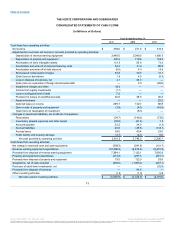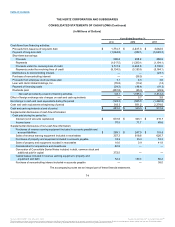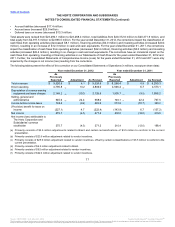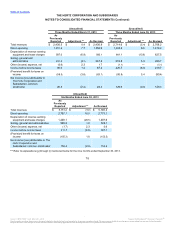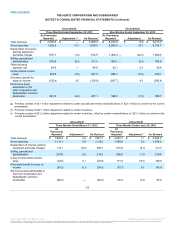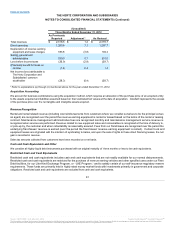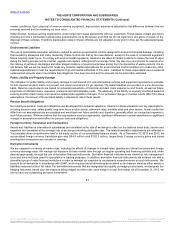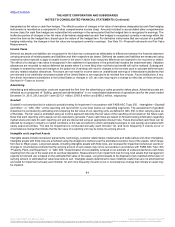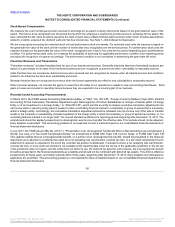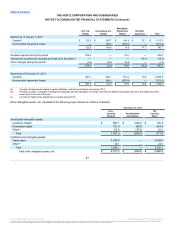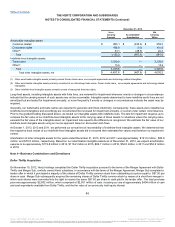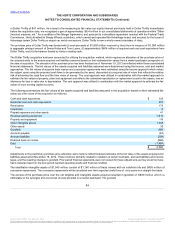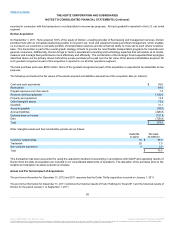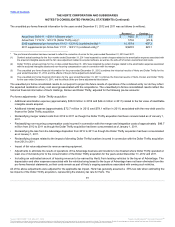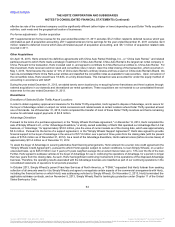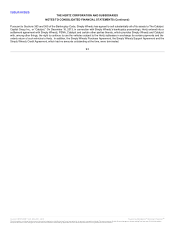Hertz 2013 Annual Report Download - page 86
Download and view the complete annual report
Please find page 86 of the 2013 Hertz annual report below. You can navigate through the pages in the report by either clicking on the pages listed below, or by using the keyword search tool below to find specific information within the annual report.
Table of Contents
market conditions. Upon disposal of revenue earning equipment, depreciation expense is adjusted for the difference between the net
proceeds received and the remaining net book value.
Within Donlen, revenue earning equipment is under longer term lease agreements with our customers. These leases contain provisions
whereby we have a contracted residual value guaranteed to us by the lessee, such that we do not experience any gains or losses on the
disposal of these vehicles. Therefore depreciation rates on these vehicles are not adjusted at any point in time per the associated lease
contract.
Environmental Liabilities
The use of automobiles and other vehicles is subject to various governmental controls designed to limit environmental damage, including
that caused by emissions and noise. Generally, these controls are met by the manufacturer, except in the case of occasional equipment
failure requiring repair by us. To comply with environmental regulations, measures are taken at certain locations to reduce the loss of vapor
during the fueling process and to maintain, upgrade and replace underground fuel storage tanks. We also incur and provide for expenses for
the cleanup of petroleum discharges and other alleged violations of environmental laws arising from the disposition of waste products. We do
not believe that we will be required to make any material capital expenditures for environmental control facilities or to make any other
material expenditures to meet the requirements of governmental authorities in this area. Liabilities for these expenditures are recorded at
undiscounted amounts when it is probable that obligations have been incurred and the amounts can be reasonably estimated.
Public Liability and Property Damage
The obligation for public liability and property damage on self-insured U.S. and international vehicles and equipment represents an estimate
for both reported accident claims not yet paid, and claims incurred but not yet reported. The related liabilities are recorded on a non-discounted
basis. Reserve requirements are based on actuarial evaluations of historical accident claim experience and trends, as well as future
projections of ultimate losses, expenses, premiums and administrative costs. The adequacy of the liability is regularly monitored based on
evolving accident claim history and insurance-related state legislation changes. If our estimates change or if actual results differ from these
assumptions, the amount of the recorded liability is adjusted to reflect these results.
Pension Benefit Obligations
Our employee pension costs and obligations are developed from actuarial valuations. Inherent in these valuations are key assumptions,
including discount rates, salary growth, long-term return on plan assets, retirement rates, mortality rates and other factors. Actual results that
differ from our assumptions are accumulated and amortized over future periods and, therefore, generally affect our recognized expense in
such future periods. While we believe that the assumptions used are appropriate, significant differences in actual experience or significant
changes in assumptions would affect our pension costs and obligations.
Foreign Currency Translation and Transactions
Assets and liabilities of international subsidiaries are translated at the rate of exchange in effect on the balance sheet date; income and
expenses are translated at the average rate of exchange prevailing during the year. The related translation adjustments are reflected in
“Accumulated other comprehensive loss” in the equity section of our consolidated balance sheets. As of December 31, 2013 and 2012, the
accumulated foreign currency translation gain was $54.8 million and $102.3 million, respectively. Foreign currency gains and losses
resulting from transactions are included in earnings.
Derivative Instruments
We are exposed to a variety of market risks, including the effects of changes in interest rates, gasoline and diesel fuel prices and foreign
currency exchange rates. We manage our exposure to these market risks through our regular operating and financing activities and, when
deemed appropriate, through the use of derivative financial instruments. Derivative financial instruments are viewed as risk management
tools and have not been used for speculative or trading purposes. In addition, derivative financial instruments are entered into with a
diversified group of major financial institutions in order to manage our exposure to counterparty nonperformance on such instruments. We
account for all derivatives in accordance with GAAP, which requires that all derivatives be recorded on the balance sheet as either assets or
liabilities measured at their fair value. For derivative instruments that are designated and qualify as hedging instruments, we designate the
hedging instrument, based upon the exposure being hedged, as either a fair value hedge or a cash flow hedge. As of December 31, 2013, we
did not have any outstanding derivative instruments
83
Source: HERTZ CORP, 10-K, March 31, 2014 Powered by Morningstar® Document Research℠
The information contained herein may not be copied, adapted or distributed and is not warranted to be accurate, complete or timely. The user assumes all risks for any damages or losses arising from any use of this information,
except to the extent such damages or losses cannot be limited or excluded by applicable law. Past financial performance is no guarantee of future results.


